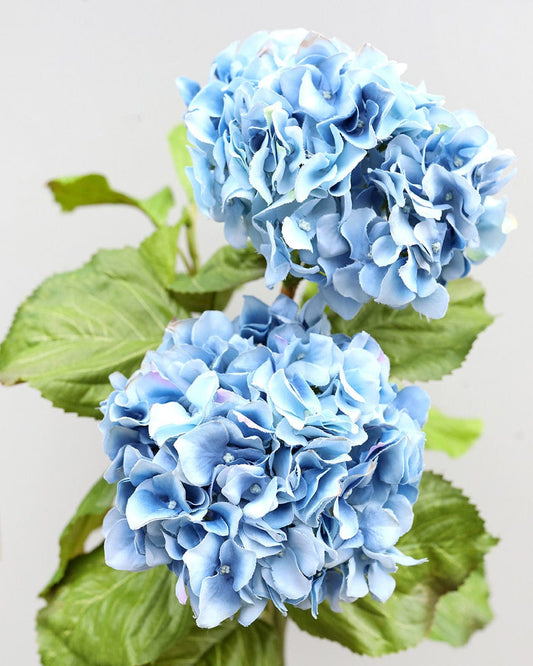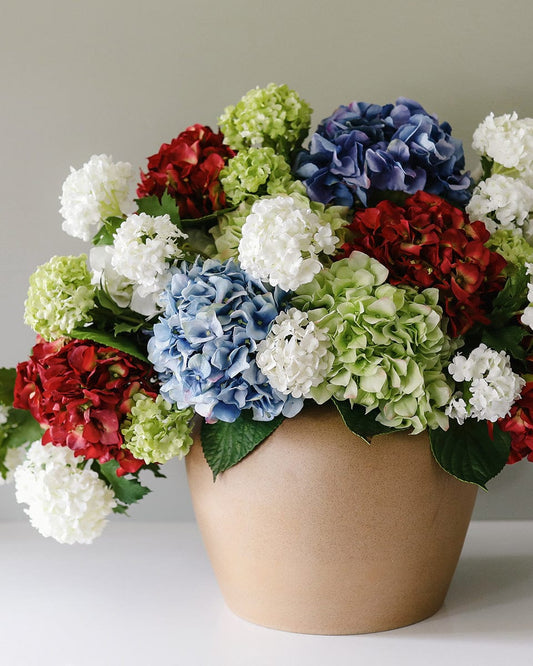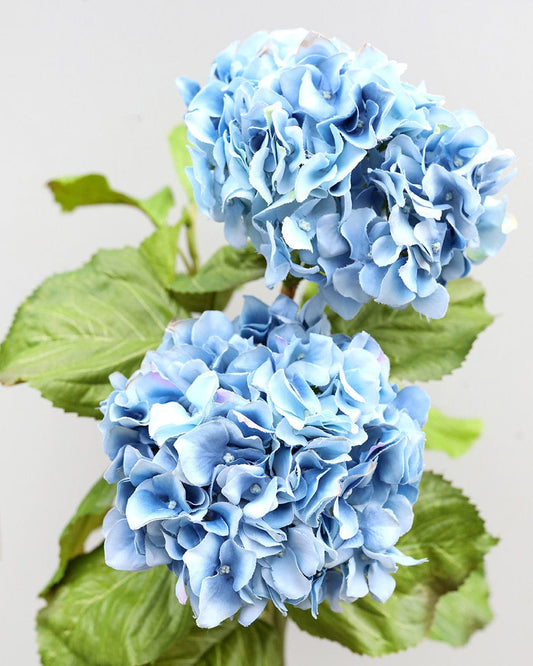Seasonal Decorating with Faux Hydrangeas: Year-Round Color and Style

Standing in my design studio last week, surrounded by an array of faux hydrangeas in every imaginable hue, I watched a client's eyes widen with delight. "I had no idea artificial hydrangeas could look so real," she whispered, gently touching the petals of a blue butterfly hydrangea. This moment perfectly captures why I'm so passionate about artificial hydrangeas – they offer that perfect combination of breathtaking beauty and practical versatility that transforms spaces throughout the year.
What makes hydrangeas particularly special for seasonal decorating is their chameleon-like ability to shift from spring freshness to autumn richness with just a change in color palette. Unlike many flowering plants that have a distinct seasonal identity, hydrangeas transcend these boundaries, making them my go-to recommendation for clients seeking year-round botanical elegance without the maintenance.
Key Takeaways
- Faux hydrangeas provide consistent color and beauty across all seasons
- Color selection should complement each season's natural palette
- Strategic placement creates different seasonal moods and focal points
- Pairing with seasonal accents refreshes arrangements without complete redesigns
- High-quality faux hydrangeas are a sustainable investment for year-round decor
Spring Awakening: Fresh Beginnings with Hydrangeas
Spring calls for a revival of freshness and light in our homes, and this is where faux hydrangeas truly shine. I've found that blue and green hydrangea varieties perfectly capture spring's awakening energy. They bring that sense of renewed life indoors, especially when natural hydrangeas haven't yet bloomed in gardens. The beauty of artificial versions is that you can enjoy their full, lush appearance while actual hydrangea bushes are still developing their first leaves.
For a client in Seattle whose home received limited natural light, I created a spring arrangement using blue hydrangeas that brightened her living space months before her garden varieties bloomed. The psychological impact was remarkable – she mentioned how the arrangement lifted her spirits during the Pacific Northwest's notorious gray spring days. This illustrates why I believe thoughtfully placed artificial blooms can genuinely affect our emotional well-being.
The Blue Butterfly Hydrangea offers exactly the fresh spring aesthetic that many of my clients seek during this season. Its delicate petals and captivating blue tones create an instant feeling of springtime renewal.
I typically arrange three to five stems in a clear glass cylinder vase, allowing plenty of space between blooms to create that light, airy feeling that embodies spring. The stems can be gently bent to create a natural, slightly cascading effect that mimics how hydrangeas grow in gardens.
Summer Abundance: Bold Hydrangea Statements
Summer is when hydrangeas reach their peak magnificence in nature, with full, dramatic blooms that command attention. This is precisely the energy we want to capture in summer decorating – that sense of lush abundance and vibrant color. To achieve this abundant look without overwhelming your budget or space, discover professional techniques for creating full hydrangea arrangements with minimal stems that capture summer's richness perfectly.
I recently designed a summer display for an outdoor wedding reception that needed to withstand heat and sun exposure. Using the Blue Double Hydrangea as my focal point created a stunning impact that lasted throughout the event and became a keepsake for the couple afterward. The guests were genuinely shocked to discover the arrangements weren't fresh-cut – a reaction I've grown quite accustomed to!
For summer styling, I recommend a more condensed arrangement that showcases the full volume of these magnificent blooms. Place three double hydrangeas in a ceramic pitcher or substantial vase, keeping the stems relatively short to create that full, abundant look. The density of the arrangement reflects summer's richness.
What makes summer hydrangea arrangements particularly effective is their versatility in both indoor and outdoor settings. I've created stunning centerpieces for covered patios that withstand summer conditions while providing that perfect touch of refined natural beauty that complements relaxed summer entertaining.
Autumn Transition: Hydrangeas in Seasonal Harmony
Autumn brings a fascinating transformation to natural hydrangeas as their colors deepen and petals develop beautiful vintage-like qualities. This natural aging process can be perfectly captured with silk hydrangeas in green tones that feature subtle burgundy or amber edges. I find this seasonal transition particularly fascinating to recreate with artificial varieties.
Last fall, I worked with a client who wanted to maintain hydrangeas as her signature flower throughout her home but needed them to reflect the changing season. The Green Double Hydrangea with its natural color variations and subtle burgundy-kissed petals provided exactly the autumnal sophistication she was seeking.
For autumn arrangements, I place hydrangeas in warmer-toned containers – copper, amber glass, or wooden vessels enhance that seasonal transition beautifully. I arrange them with slightly more visible stem length than summer displays, creating a more architectural look that complements autumn's structural aesthetic.
The autumn transition also offers a perfect opportunity to incorporate hydrangea foliage. The large, textured leaves add wonderful dimension to arrangements and connect beautifully with other fall elements like dried grasses or small pumpkins. Have you ever noticed how hydrangea leaves develop those beautiful reddish edges in autumn? Quality artificial versions capture this detail beautifully.
Winter Elegance: Timeless Hydrangea Styling
Winter presents a unique opportunity for hydrangea styling, especially since natural hydrangeas aren't typically available during colder months. This is when cream and white artificial hydrangea flowers truly shine, creating that frost-kissed elegance that complements winter's serene aesthetic. I've found that these lighter varieties create a beautiful connection to winter's quiet beauty.
For a holiday home tour last December, I created a series of winter-white arrangements that became the most photographed elements of the design. The Cream White Cone Hydrangea provided that perfect sculptural quality that worked beautifully with the home's minimalist winter decor scheme.
For winter arrangements, I often create more dramatic height variations, with some stems standing quite tall while others cascade lower. This vertical interest reflects winter's stark beauty and creates stunning silhouettes, especially when backlit.
What I find particularly effective about winter hydrangea arrangements is their ability to transition from holiday to general winter decor. Unlike explicitly Christmas-themed decor that needs to be packed away, elegant white hydrangeas can remain through February, evolving with simple adjustments to their accompanying elements. Have you considered how a single flower variety can adapt so beautifully across an entire season with just minor styling changes?
Creating Your Hydrangea Haven
Throughout my years working with artificial flowers, I've discovered that high-quality faux hydrangeas offer unparalleled versatility for year-round decorating. While hydrangeas excel in this adaptability, you might also consider how hydrangeas compare to other premium artificial flowers like ranunculus when planning your seasonal decor strategy. The key is selecting varieties with botanical accuracy and thoughtful color variations that capture the essence of each season.
I encourage you to think beyond traditional vase arrangements too. Hydrangea blooms can be incorporated into wreaths, garlands, or even as single stems in bud vases throughout your home. Their substantial presence means even a single stem creates impact, making them economical as well as beautiful. Consider how you might incorporate these versatile blooms into your own seasonal decorating rhythm, creating a home that evolves gracefully through the year while maintaining your personal aesthetic.
Remember that quality matters tremendously with artificial flowers. The hydrangeas I've shared today represent the pinnacle of botanical realism, with carefully crafted petals and color variations that mimic nature's own artistry. Your home deserves this level of authenticity – flowers that don't announce themselves as artificial, but simply exist as beautiful hydrangeas, regardless of their medium.
Frequently Asked Questions
How do I keep my faux hydrangeas looking fresh and dust-free?
I recommend a gentle approach – either use a hair dryer on the cool setting to blow dust away, or for more thorough cleaning, fill a basin with lukewarm water and a drop of mild dish soap, then dip and swish the blooms briefly. Allow them to air dry completely upside down. For delicate varieties, a soft makeup brush works wonders for dusting between petals.
Can I mix faux hydrangeas with real flowers?
Absolutely! I often create mixed arrangements for clients. The trick is to use your artificial hydrangeas as the structural foundation, then incorporate fresh flowers with shorter lifespans around them. This gives you the best of both worlds – the lasting structure of quality faux blooms with the fragrance and temporal beauty of fresh accents.
What containers work best with artificial hydrangeas?
Hydrangeas are incredibly versatile, but I find they look particularly stunning in ceramic pitchers, weathered metal containers, woven baskets, and glass cylinders. The key is choosing a container with enough weight and substance to balance the visual heft of hydrangea blooms. For single stems, narrow-necked vessels provide the necessary support.
How many hydrangea stems do I need for an impactful arrangement?
For most standard vases (8-10 inches in diameter), three to five stems create the perfect balance. Hydrangeas have substantial blooms, so fewer stems are needed compared to smaller flowers. I often recommend starting with three stems of the same variety, then adding complementary flowers or greenery if more fullness is desired.
Start your year-round hydrangea journey today by exploring our complete collection of premium artificial hydrangeas, carefully curated to provide endless seasonal decorating possibilities for your home.


















